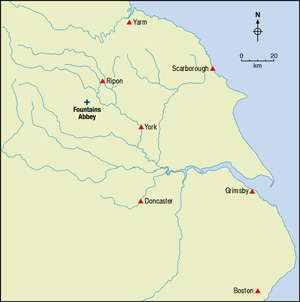 |
 |
 |
 |
 |
 |
 |
|
Fountains Abbey: History
Fountains Abbey: Buildings
|
Urban holdings (33/33) Whilst the Cistercians sought to live ‘far from the haunts of men’, and worked the land from their granges, they required urban holdings for trade and also to provide accommodation for the abbot and abbey officials. Fountains therefore had a number of urban holdings in Boston (Lincolnshire), Doncaster, Grimsby, Ripon, Scarborough, Yarm and York.(147) Significantly, all but two -Ripon and Doncaster - were in ports, a reflection of the importance of the wool trade and also fishing. The most important of Fountains’ urban holdings were at Boston and York. Boston was an important port for the export of wool to Flanders and Italy.(148) The community’s main property here was in Wormgate, which is today known as ‘Fountains Lane’.(149) This was acquired, or at least access to the property was acquired, in the late twelfth century from Jordan de Boston. In return for a payment of five shillings per year, Jordan granted the monks a chamber in town, next to his house, with an enclosed court and other buildings that they might use at the time of the fair of St. Botulph; Jordan alone would have access at all other times and he would maintain the property.(150) Fountains later expanded their holdings in Boston, acquiring two mills and property at Boston in Emery Lane, on the west bank of the R. Witham.(151)
Most of Fountains’ urban property was in York, near to the river. The community gained a foothold here in the late twelfth century and continued to expand its holdings until the fourteenth century. York was an important centre for the wool trade and also for fishing, but the properties here were also used as hospices by the abbot of Fountains and monastic officials, and the mid-fifteenth century ‘Bursar’s Account Book’ records the payment of four pennies for a candelabra for the York hospice in 1456-7, and annual payments for mowing.(152) Thomas Swinton’s ‘Memorandum Book’, that records his payments and activities as a leading monastic official at Fountains in the mid-fifteenth century, reveals that he and his companion stayed at the York hospice for five days during Lent with details of the expenses incurred at this time, including 3s 2 d on bread (for themselves and their horses), 2 s 2d on wine, 6d on horseshoes.(153) Fountains still maintained property in York in the sixteenth century, in North Street.(154) |
